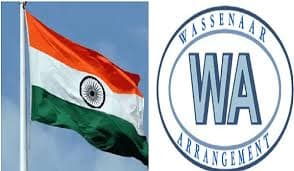What’s in today’s article?
- Why in News?
- About Wassenaar Arrangement (History, Purpose, Working, Members, etc.)
- News Summary
Why in News?
- India will assume chairmanship of the plenary of the Wassenaar Arrangement for a year on January 1, 2023.
What is Wassenaar Arrangement?
- The Wassenaar Arrangement is a voluntary export control regime. The body came into being in 1996 to succeed the Cold War-era Coordinating Committee for Multilateral Export Controls.
- The name comes from Wassenaar, a suburb of the Hague, Netherlands, where the agreement to start such a multi-lateral cooperation was reached in 1995.
- Its headquarters is in Vienna, Austria.
What is the purpose of Wassenaar Arrangement?
- The purpose of the Wassenaar Arrangement is to promote transparency and greater responsibilities for transfers of conventional arms and dual-use goods, as well as technologies, to prevent destabilizing actions.
How does Wassenaar Arrangement work?
- The group works by regularly exchanging information in respect of technology, both conventional and nuclear-capable, that is sold to, or denied to countries outside the grouping.
- This is done through maintenance and updating of detailed lists of chemicals, technologies, processes and products that are considered militarily significant.
- Through this exchange of information, the group aims at controlling the movement of technology, material or components to countries or entities which undermine international security and stability.
- The aim, according to WA, is also to prevent the acquisition of these items by terrorists.
What are Wassenaar Control Lists?
- The Arrangement works according to what it calls WA Control Lists.
- WA members agree to exchange information on sensitive dual-use goods and technologies and report on such transfers and denials of controlled items to non-participants.
- The controls are subject to ratification by the participants.
Who are the members of Wassenaar Arrangement?
- The WA has 42 members.
- India became a member of the WA in 2017.
- With the exception of China, all the other permanent members of the U.N. Security Council are signatories of the WA.
News Summary:
- On December 1, 2022, at the 26th annual plenary of the Wassenaar arrangement in Vienna, Ambassador of Ireland handed over the chairmanship to India’s Ambassador and Permanent Representative to the UN, Jaideep Mazumdar.
- As a chair of the plenary, India would be in a position to steer discussions of the group to further strengthen the export controls to prevent arms diversion to terrorists or to sovereign nations supporting terrorism.
What is the significance of India’s Chairmanship to Wassenaar Arrangement?
- India’s chairmanship of the WA Plenary is also significant in the long run considering the recent spurt in investment and activity in the local defense and space sectors.
- As the chair of the WA, India could play a significant role in democratizing access to technologies and processes that can serve as crucial building blocks for the newly emerging defense and space manufacturing sectors in India.
- India is slowly emerging as a low-cost producer of several items in the WA’s control lists.
- At the helm of the plenary, India’s chair ship would go a long way in establishing the credibility of the country as a responsible stakeholder in the global non-proliferation architecture.
Q1) Is Wassenaar agreement legally binding?
No. This regime is a voluntary association, not bound by a treaty, and therefore has no formal mechanism to enforce compliance.
Q2) Who are member countries of Wassenaar Arrangement?
The 42 participating states in the Wassenaar Arrangement are Argentina, Australia, Austria, Belgium, Bulgaria, Canada, Croatia, the Czech Republic, Denmark, Estonia, Finland, France, Germany, Greece, Hungary, India, Ireland, Italy, Japan, Latvia, Lithuania, Luxembourg, Malta, Mexico, Netherlands, New Zealand, Norway, Poland, Portugal, Romania, Russia, Slovakia, Slovenia, South Africa, South Korea, Spain, Sweden, Switzerland, Turkey, Ukraine, the United Kingdom, and the United States.
Last updated on December, 2025
→ Check out the latest UPSC Syllabus 2026 here.
→ Join Vajiram & Ravi’s Interview Guidance Programme for expert help to crack your final UPSC stage.
→ UPSC Mains Result 2025 is now out.
→ UPSC Notification 2026 is scheduled to be released on January 14, 2026.
→ UPSC Calendar 2026 is released on 15th May, 2025.
→ The UPSC Vacancy 2025 were released 1129, out of which 979 were for UPSC CSE and remaining 150 are for UPSC IFoS.
→ UPSC Prelims 2026 will be conducted on 24th May, 2026 & UPSC Mains 2026 will be conducted on 21st August 2026.
→ The UPSC Selection Process is of 3 stages-Prelims, Mains and Interview.
→ UPSC Result 2024 is released with latest UPSC Marksheet 2024. Check Now!
→ UPSC Prelims Result 2025 is out now for the CSE held on 25 May 2025.
→ UPSC Toppers List 2024 is released now. Shakti Dubey is UPSC AIR 1 2024 Topper.
→ UPSC Prelims Question Paper 2025 and Unofficial Prelims Answer Key 2025 are available now.
→ UPSC Mains Question Paper 2025 is out for Essay, GS 1, 2, 3 & GS 4.
→ UPSC Mains Indian Language Question Paper 2025 is now out.
→ UPSC Mains Optional Question Paper 2025 is now out.
→ Also check Best IAS Coaching in Delhi

















